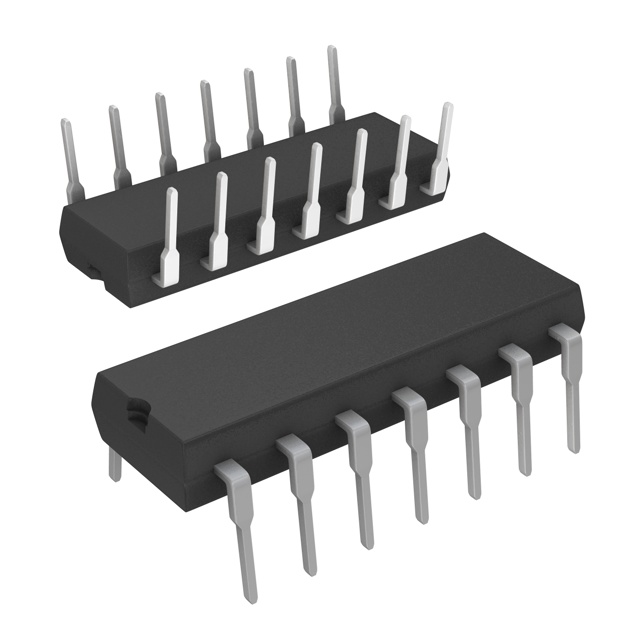PIC16LF1824-I/P
Product Overview
Category
The PIC16LF1824-I/P belongs to the category of microcontrollers.
Use
This microcontroller is commonly used in various electronic devices and embedded systems for controlling and processing data.
Characteristics
- Low power consumption
- High performance
- Small form factor
- Wide operating voltage range
- Enhanced peripheral integration
Package
The PIC16LF1824-I/P is available in a 14-pin plastic dual inline package (PDIP).
Essence
The essence of this microcontroller lies in its ability to provide efficient control and processing capabilities in a compact and low-power package.
Packaging/Quantity
The PIC16LF1824-I/P is typically packaged in reels or tubes, with quantities varying depending on the supplier and customer requirements.
Specifications
- Architecture: 8-bit
- CPU Speed: Up to 32 MHz
- Flash Memory: 7 KB
- RAM: 256 bytes
- Operating Voltage Range: 1.8V to 5.5V
- Digital I/O Pins: 12
- Analog Input Channels: 6
- Timers: 2
- Communication Interfaces: SPI, I2C, UART
Detailed Pin Configuration
The PIC16LF1824-I/P has a total of 14 pins, each serving a specific purpose. The pin configuration is as follows:
- VDD - Power supply voltage
- RA0/AN0 - Analog input or digital I/O
- RA1/AN1 - Analog input or digital I/O
- RA2/AN2 - Analog input or digital I/O
- RA3/AN3 - Analog input or digital I/O
- RA4/T0CKI/C1OUT - Timer input or digital I/O
- RA5/AN4/SS - Analog input or digital I/O
- VSS - Ground
- RC0/T1OSO/T1CKI/CCP2 - Timer input or digital I/O
- RC1/T1OSI/CCP1 - Timer input or digital I/O
- RC2/CCP1 - Timer input or digital I/O
- RC3/SCL - I2C communication interface or digital I/O
- RC4/SDA - I2C communication interface or digital I/O
- RC5/SDO - SPI communication interface or digital I/O
Functional Features
- Enhanced core with improved performance and efficiency
- Integrated peripherals for various applications
- Low power consumption modes for energy-efficient operation
- Flexible communication interfaces for seamless connectivity
- Rich set of timers and interrupts for precise timing control
- On-chip analog-to-digital converter (ADC) for sensor interfacing
Advantages and Disadvantages
Advantages
- Compact size and low power consumption make it suitable for portable devices
- High-performance capabilities enable efficient data processing
- Wide operating voltage range allows compatibility with different power sources
- Integrated peripherals reduce the need for external components, saving cost and board space
Disadvantages
- Limited flash memory and RAM may restrict the complexity of applications
- 8-bit architecture may not be sufficient for certain demanding tasks
- Lack of advanced features found in higher-end microcontrollers
Working Principles
The PIC16LF1824-I/P operates based on an 8-bit architecture, where instructions are executed sequentially. It utilizes a central processing unit (CPU) to fetch, decode, and execute instructions stored in its flash memory. The microcontroller interacts with external devices through its I/O pins and communication interfaces.
Detailed Application Field Plans
The PIC16LF1824-I/P finds applications in various fields, including but not limited to: - Consumer electronics - Industrial automation - Automotive systems - Medical devices - Home appliances
Detailed and Complete Alternative Models
Some alternative models that offer similar functionality to the PIC16LF1824-I/P include: - PIC16LF1825-I/P - PIC16LF1826-I/P - PIC16LF1827-I/P - PIC16LF1828-I/P
These models have comparable specifications and pin configurations, providing flexibility for different project requirements.
In conclusion, the PIC16LF1824-I/P is a versatile microcontroller with low power consumption, high performance, and integrated peripherals. It finds applications in various fields and offers a range of features suitable for controlling and processing data in embedded systems.
Senaraikan 10 soalan dan jawapan biasa yang berkaitan dengan aplikasi PIC16LF1824-I/P dalam penyelesaian teknikal
What is the operating voltage range of PIC16LF1824-I/P?
- The operating voltage range of PIC16LF1824-I/P is 1.8V to 5.5V.Can PIC16LF1824-I/P be used in battery-powered applications?
- Yes, PIC16LF1824-I/P's low operating voltage makes it suitable for battery-powered applications.What are the key features of PIC16LF1824-I/P?
- Some key features of PIC16LF1824-I/P include 14-bit core, nanoWatt XLP technology, and multiple communication interfaces.Is PIC16LF1824-I/P suitable for temperature sensing applications?
- Yes, PIC16LF1824-I/P has analog-to-digital conversion capabilities that make it suitable for temperature sensing applications.Can PIC16LF1824-I/P be programmed using C language?
- Yes, PIC16LF1824-I/P can be programmed using C language with the appropriate compiler.What is the maximum clock frequency supported by PIC16LF1824-I/P?
- PIC16LF1824-I/P supports a maximum clock frequency of 32 MHz.Does PIC16LF1824-I/P have built-in EEPROM memory?
- Yes, PIC16LF1824-I/P has 256 bytes of EEPROM memory for data storage.Can PIC16LF1824-I/P be used in motor control applications?
- Yes, PIC16LF1824-I/P's pulse-width modulation (PWM) module makes it suitable for motor control applications.What development tools are available for programming PIC16LF1824-I/P?
- Development tools such as MPLAB X IDE and PICkit programmers are available for programming PIC16LF1824-I/P.Is PIC16LF1824-I/P suitable for low-power applications?
- Yes, PIC16LF1824-I/P's nanoWatt XLP technology enables it to be used in low-power applications, extending battery life.


